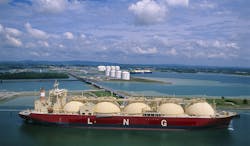The development of U.S. natural gas resources is not only having a transformative impact on the U.S. energy landscape, but also leading to a huge increase globally in Liquefied Natural Gas liquefaction capacity.
Global LNG capacity would more than double from 341 million tons per annum (mtpa) in 2015 to 811 mtpa by 2019 based on proposed LNG liquefaction capacity projects, according to research and consulting firm GlobalData.
GlobalData’s latest report states that the scale of the North American project pipeline is unparalleled, totaling 32 individual liquefaction plants with over 287 mtpa of capacity through the end of the decade. Dramatic LNG liquefaction capacity growth is also anticipated in Africa, Europe and Asia.
Matthew Jurecky, GlobalData’s Head of Oil & Gas Research and Consulting, says this massive infrastructure build-out in the U.S. is driven by unconventional gas in North America.
"Years of lobbying for regulatory approval and building out liquefaction capacity has paid off, and the global market will now have to make room for significant increasing volumes of North American gas," Jurecky said.
The increase in domestic natural gas production is expected to continue with the U.S. Energy Information Administration forecasting a record average production rate of 79.06 Bcf/d in 2015.
"Shale operators in North America have eyed international markets since 2009, when BG Group entered into a joint venture with Exco Resources in the Haynesville Shale," Jurecky said. "Shortly after, in 2010, the first application for an LNG export facility in the U.S. was made by Cheniere, before BG announced a long-term LNG sale and purchase agreement with Cheniere in 2011.
"With Shell acquiring BG in early 2015, the global LNG leader is now also lined up behind the emerging U.S. shale gas export market."
Jurecky adds that the capital expenditure required to execute the planned global projects is estimated at approximately $700 billion, almost half of which is allocated to projects in North America.
READ ALSO: LNG’s Role In The Natural Gas Marketplace
Earlier this month, the Department of Energy issued a final authorization to American LNG Marketing LLC to export domestically produced LNG to countries that do not have a Free Trade Agreement (FTA) with the United States. American LNG is authorized to export LNG up to the equivalent of 0.008 billion cubic feet per day (Bcf/d) of natural gas for a period of 20 years from the liquefaction facility located near Medley, Florida in Miami-Dade County using approved ISO LNG containers.
Similarly, in May the Energy Department issued authorization for Dominion Cove Point LNG, LP to export domestically produced liquefied natural gas (LNG) to countries without an FTA. The Cove Point LNG Terminal in Calvert County, Maryland is authorized to export LNG up to the equivalent of 0.77 billion standard cubic feet per day (Bcf/d) of natural gas for a period of 20 years.
U.S. federal law generally requires approval of natural gas exports to countries that have a Free Trade Agreement with the U.S. For countries that do not have an FTA, the Natural Gas Act directs the Department of Energy to grant export authorizations unless the Department finds that the proposed exports "will not be consistent with the public interest."
The Energy Department says it will continue to act on applications to export LNG from the lower 48 states after completion of the review required by the National Environmental Policy Act, and when DOE has sufficient information on which to base a public interest determination.
In addition to the growth in LNG liquefaction capacity, Jurecky also said that global LNG regasification capacity is expected to grow by around 50 percent, from 41 trillion cubic feet (tcf) in 2015 to 60 tcf by 2019.
"The massive growth in liquefaction is commensurate with the proposed growth in regasification capacity," he said. "Continued demand growth in Asia and an alternative to pipeline natural gas in Europe underlies the $34 billion in capital expenditure behind new LNG regasification projects.
"China and India will lead regasification additions, with a combined $20.6 billion proposed to increase regasification capacity by 7 tcf in the two countries by 2019. In Europe, Canatxx LNG Limited is planning a massive LNG import terminal in the UK with a total capacity of over 1 tcf."


